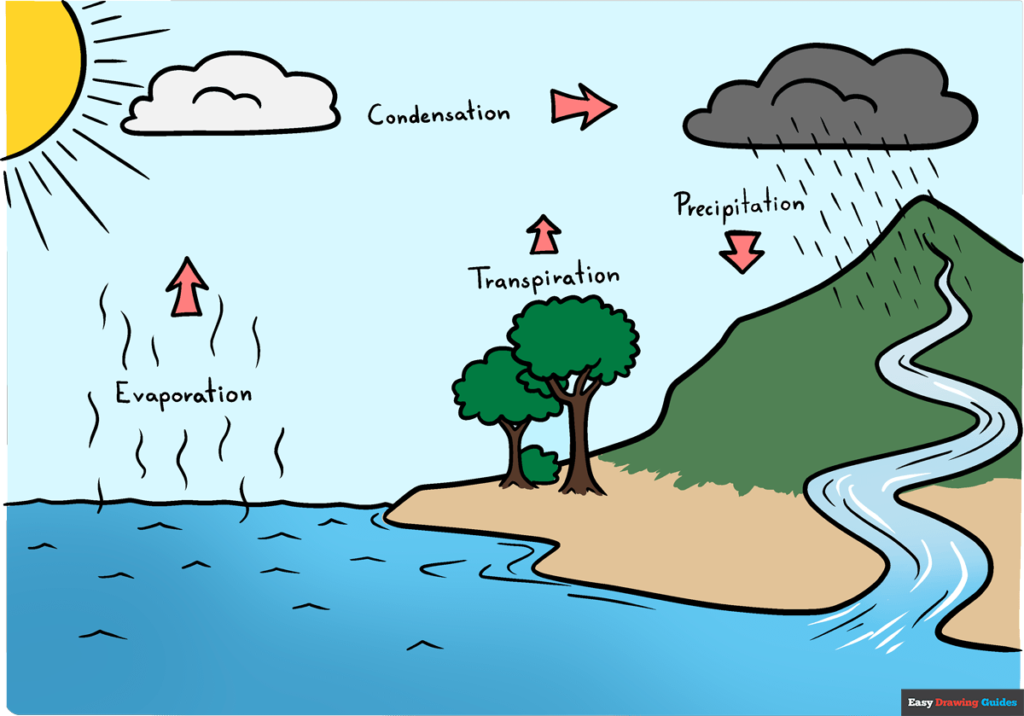INTRODUCTION
The water cycle, referred to as the hydrological cycle, is the continual circulation of water across, over, and beneath the Earth’s surface. Water evaporates off the Earth’s surface to the sky, condenses into clouds, rains back to the Earth as rainfall, and then runs into rivers, lakes, and oceans, where it will be evaporated repeatedly. The water cycle is powered by sunlight and gravity, and it is important to preserving water balance on Earth while supporting life.
WHAT IS WATER?
Water is an odorless, colorless, and tasteless liquid that is required by every living organism. It is a chemical compound with a molecular structure of H2O, consisting of two atoms of hydrogen and one oxygen atom. Water can be present in a wide range of habitats, including deep subterranean aquifers and the Earth’s atmosphere.
Water is a single substance that is able to exist in three distinct states: solid (ice), liquid (water), and gas (water vapor). It is strongly polar, which means that one end has a partial positive charge while the other end has a partial negative charge. Water is a great solvent because of this feature, which allows it to dissolve a wide range of other compounds, including salts, sugars, and acids.
Water is necessary for life, as it is involved in activities such as photosynthesis, digestion, and cellular respiration. It is also crucial for climate regulation since it transfers heat and energy across the world.
Despite its abundance, many parts of the world are experiencing water scarcity, which is frequently worsened by climate change and human activity. Water pollution is also a serious issue, with numerous bodies of water affected by industrial discharge, agricultural runoff, and other pollution sources.

STEPS OF WATER CYCLE
The water cycle consists of several steps that continuously repeat, and they include:
- Evaporation: The sun’s heat drives the water in oceans, rivers, lakes, and various other sources of water to evaporate towards the atmosphere, where it condenses to produce water vapor.
- Condensation: Water vapor rises towards the atmosphere and cools down, resulting in the formation of clouds.
- Precipitation: The water droplets in the clouds mix and become larger before they fall back onto the Earth as rain, snow, hail, or sleet.
- Infiltration: Precipitation that rains on land can penetrate into the earth (known as infiltration) or runs into rivers and streams.
- Runoff: Runoff is the extra precipitation that isn’t absorbed by the ground and runs into rivers, lakes, and seas.
- Transpiration: Plants take water from the soil and expel it into the atmosphere via a process known as transpiration, adding to the amount of water vapor in the atmosphere.
- Percolation: Water that penetrates into the earth flows downhill through the soil and rocks until it reaches aquifers beneath the surface.
- Sublimation: Sublimation is the process by which water changes from a solid (ice or snow) to a gas without initially turning into a liquid.
These phases work together to continually cycle water through the Earth’s system, guaranteeing a steady supply of fresh water for plants, animals, and humans.
IMPORTANCE OF WATER CYCLE
The water cycle is critical for supporting life on Earth, and it has several important benefits, including:
- Providing freshwater: The water cycle constantly refills the Earth’s freshwater supply, which is critical for the survival of plants, animals, and people.
- Climate regulation: The circulation of water in the atmosphere aids in the regulation of temperatures and climate trends such as the distribution of precipitation and heat throughout the world.
- Ecosystem support: The water cycle sustains an array of ecosystems, including wetlands, lakes, and rivers, which provide home for a diverse range of plant and animal species.
- Contributing to agriculture: The water cycle gives crops with the water they require to flourish, hence sustaining agricultural and food production.
- Energy generation: The flow of water in rivers and streams may be used to create hydroelectric electricity.
- Water purification: The water cycle helps to cleanse water by eliminating contaminants as it flows through the system, such as through the infiltration and percolation processes.
In conclusion, the water cycle is a vital mechanism that sustains life on Earth in different ways and contributes to the preservation of a healthy and sustainable world.
HUMAN IMPACT ON WATER CYCLE
Human activities can have significant impacts on the water cycle. Some of the ways in which humans affect the water cycle include:
- Deforestation: Clearing trees and other vegetation lowers the quantity of water absorbed by the land, resulting in increased runoff and erosion.
- Changes in land use: Urbanization and agriculture can modify the terrain and water flow, resulting in changes in runoff patterns and possible flooding.
- Water extraction: Because humans withdraw vast amounts of water from rivers, lakes, and aquifers for agriculture, industry, and residential usage, these resources can become depleted.
- Climate change: Human actions such as the use of fossil fuels and deforestation contribute to climate change, which alters precipitation and evaporation patterns, resulting in extreme weather conditions such as drought and flooding.
- Water contamination: Human actions such as industrial release, agricultural runoff, and discharges of wastewater can pollute bodies of water, resulting in water pollution and a negative influence on the health of aquatic ecosystems.
These human impacts on the water cycle can have significant consequences, such as reducing the availability of freshwater resources, altering the flow of water in rivers and streams, and impacting aquatic ecosystems. It is essential that we manage our use of water and reduce our impact on the water cycle to ensure the sustainability of this vital natural resource.
Learn more: